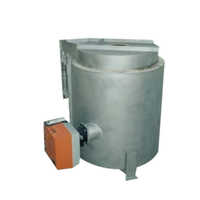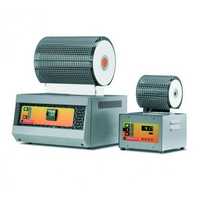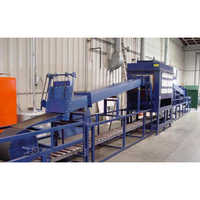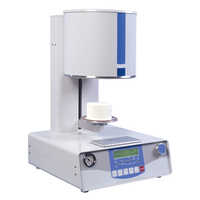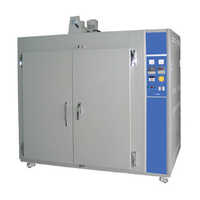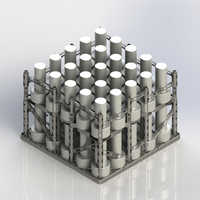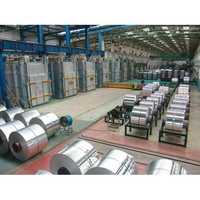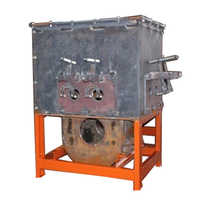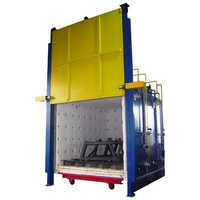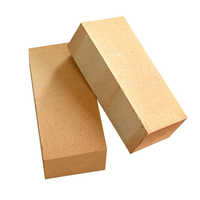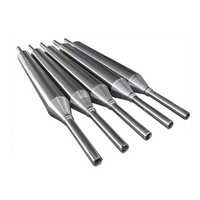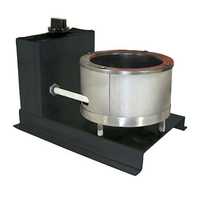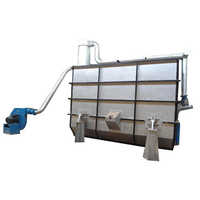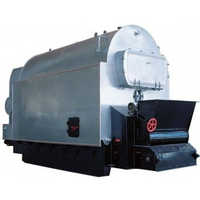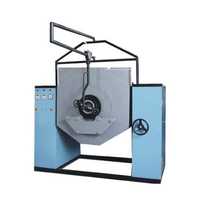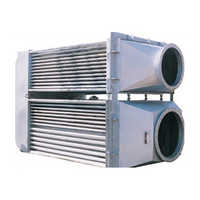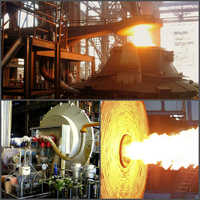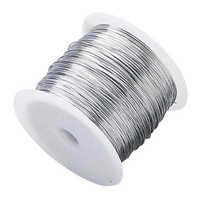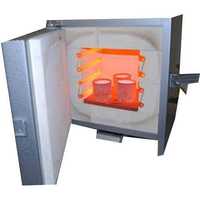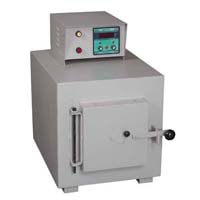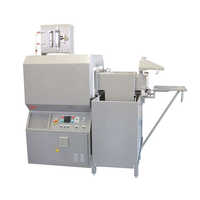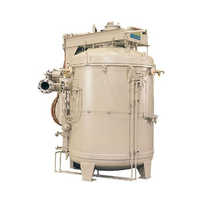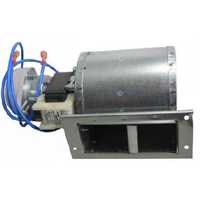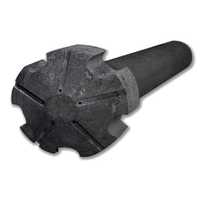Furnace Manufacturers
(2832 products)
Furnace Manufacturers specialize in crafting industrial furnaces for various applications. Their furnaces are known for their robust construction, ensuring durability and longevity. These furnaces are widely used in industries such as pharmaceuticals for precise temperature control processes. They offer a range of options, including Muffle Furnaces, Smoke House Furnaces, Electric Furnaces, Furnace Chimneys, and Furnance Di-dt, each designed to meet specific industrial needs.
...show moreThis context does not mention muffle furnace manufacturers.
The temperature range of Muffle Furnaces is 1200-1500 Celsius (oC).
The voltage of Muffle Furnaces is 110-240 Volt (v).
The material of Muffle Furnaces is aluminium.
The warranty of Smoke House Furnaces is 1 year.
Explore More Categories
Made in India
Electric Benchtop Muffle Furnace Usage: Industrial
Price: 65000 INR (Approx.)/Unit
MOQ - 1 Unit/Units
Usage - Industrial
Condition - New
3 Years
Business Type: Manufacturer | Distributor
CHROMATOGRAPHY WORLD
Made in India
Aluminium Melting Skelner Furnace
Price Trend: 1000000.00 - 7500000.00 INR (Approx.)/Piece
MOQ - 1 Piece/Pieces
7 Years
Business Type: Manufacturer | Distributor
KAMINOX INDUSTRIES
Made in India
Rotary Klin Furnaces And Incinerator
Price: 35000000 INR (Approx.)/Set
MOQ - 01 Set/Sets
13 Years
Business Type: Manufacturer | Distributor
BIOLINE TECHNOLOGIES
Temperature Furnace
8 Years
Business Type: Manufacturer | Distributor
HAIDA INTERNATIONAL EQUIPMENT CO., LTD.
Reheating Furnace
Price Trend: 100000.00 - 150000.00 INR (Approx.)/Unit
MOQ - 1 Unit/Units
Type - Other, Reheating Furnace
Material - Cast Iron
Computerized - Yes
21 Years
Business Type: Manufacturer | Supplier
UGI ENGINEERING WORKS PVT. LIMITED
Made in India
2Kg Gold Bond Metro Gold Melting Induction Furnace
Price Trend: 500000.00 - 1000000.00 INR (Approx.)/Piece
MOQ - 1 Piece/Pieces
16 Years
Business Type: Manufacturer | Supplier
ASHLYN CHEMUNNOOR INSTRUMENTS PVT. LTD.
Made in India
Muffle Furnace
20 Years
Response Rate: 70.73%
Business Type: Manufacturer | Exporter
CLASSIC SCIENTIFIC
Made in India
Muffle Furnace Application: Industrial
MOQ - 1 Unit/Units
Size - 23 x 10 x 10mm
Product Type - Muffle Furnace
Usage - Laboratory
15 Years
Business Type: Manufacturer | Distributor
META-LAB SCIENTIFIC INDUSTRIES
Muffle Furnace
Price: 35000 INR (Approx.)/Number
MOQ - 1 Number
12 Years
Business Type: Manufacturer | Exporter
HMG (INDIA)
Made in India
Muffle Furnace
14 Years
Business Type: Manufacturer | Exporter
EIE INSTRUMENTS PRIVATE LIMITED
Induction Based Copper Melting Furnace (1.5 Kg. In Three Phase)
1 Years
Business Type: Manufacturer | Supplier
Shapet Induction Company
Made in India
Furnace Selector Switches
Price Trend: 1000.00 - 10000.00 USD ($) (Approx.)/Piece
MOQ - 10 Piece/Pieces
11 Years
Business Type: Manufacturer | Exporter
THERMA FIELD POWER COMPONENTS PRIVATE LIMITED
Made in India
Compact Tube Furnace Application: Industrial
Price: 481000 INR (Approx.)/Unit
MOQ - 1 Unit/Units
Size - Different Available
Color - Grey
Condition - New
2 Years
Business Type: Supplier | Trading Company
BISHOPS SCIENTIFIC PRIVATE LIMITED
Made in India
Single Phase Muffle Furnace Application: 4 Inch X 4 Inch X 9 Inch*
Price: 45000.00 INR (Approx.)/Unit
MOQ - 1 Unit/Units
Weight - 25 Kilograms (kg)
Color - As per your requirement
Product Type - Testing Product
3 Years
Response Rate: 82.14%
Business Type: Manufacturer
TECHPLAST TESTING MACHINES
Muffle Furnace
Price: 16500 INR (Approx.)/Unit
MOQ - 1 Unit/Units
6 Years
Business Type: Trading Company
YESHA LAB EQUIPMENTS
Indian Inquiries Only
Laboratory Muffle Furnace - Application: Heating
Price: 1000 INR (Approx.)/Piece
MOQ - 1 Piece/Pieces
Condition - New
Usage - Heat Treatment furnace
Power - 220 Volt (v)
16 Years
Business Type: Manufacturer | Distributor
STANDARD STEEL
Made in India
Industrial Muffle Furnace Dimensions: 125 X 125 X 250 Mm Millimeter (Mm)
Price: 52000 INR (Approx.)/Unit
MOQ - 1 Unit/Units
Feature - Temperature Control, Temperature Control, Digital Display,Digital Display
Usage - Muffle Furnace
Power - 220 V AC Single Phase 50 Hz Volt (v)
15 Years
Business Type: Manufacturer | Supplier
TEXCARE INSTRUMENTS
Made in India
Muffle Furnace Dimensions: 150 X 150 X 300 Millimeter (Mm)
Price: 80000 INR (Approx.)/Unit
MOQ - 1 Unit/Units
Usage - Industrial
Weight - 100 Kilograms (kg)
Condition - New
13 Years
Business Type: Manufacturer | Exporter
SOUTHERN SCIENTIFIC LAB INSTRUMENTS PRIVATE LIMITED
220V Voltage 620*500*1050Mm Dimension Tilting Gold Smelting Furnace Dimensions: 620*500*1050 Millimeter (Mm)
Length - 620 Millimeter (mm)
Width - 500 Millimeter (mm)
Weight - 78 Kilograms (kg)
13 Years
Business Type: Manufacturer | Distributor
AROTEK SCIENTIFIC INSTRUMENTS PVT. LTD.
Made in India
Reheating Furnace
5 Years
Business Type: Manufacturer | Supplier
ROLLTECH ENGINEERING PVT. LTD.
Indian Inquiries Only
Blue Direct Biomass Fired Hot Air Furnace
Price Trend: 50000 - 1000000 USD ($) (Approx.)/Set
MOQ - 1 Set/Sets
Product Type - Direct Biomass Fired Hot Air Furnace
Condition - New
Type - Direct Biomass Fired Hot Air Furnace
11 Years
Business Type: Manufacturer | Distributor
Zhejiang Meibao Industrial Technology Co., Ltd.
Metal Vacuum Dewaxing Furnace
12 Years
Business Type: Manufacturer | Exporter
BRITISH SUPER ALLOYS PVT. LTD.
Indian Inquiries Only
Made in India
Scan Master Heating Furnace
Price: 1700000 INR (Approx.)/Unit
MOQ - 1 Unit/Units
1 Years
Business Type: Manufacturer | Distributor
PLASMA INDUCTION (INDIA) PRIVATE LIMITED
Made in India
18 Kilowatt 440 Voltage Easy To Install Aluminium Melting Cum Holding Furnace Application: Industrial
Price: 150000 INR (Approx.)/Unit
MOQ - 1 Unit/Units
Color - Silver
Feature - Easy To Install
Weight - 1500 Kilograms (kg)
3 Years
Business Type: Manufacturer | Supplier
CERATHERM TECHNOLOGIES INDIA PVT.LTD.
Made in India
Muffle Furnace
15 Years
Business Type: Manufacturer | Exporter
STEELFAB INDUSTRIES
Made in India
Oil Heater
12 Years
Business Type: Manufacturer | Distributor
JALDHARA INDUSTRIES
Made in India
Billet Annealing Furnace Application: For Cutting And Warping
Price: 550000.00 INR (Approx.)/Unit
MOQ - 1 Unit/Units
Color - Silver
Feature - Longer Life
Condition - New
11 Years
Business Type: Manufacturer | Distributor
PANCHASARA MACHINE TOOLS
Silver Heat Treatment Furnace
MOQ - 1 Unit/Units
Usage - Industrial
Product Type - Heat Treatment Furnace
Size - Different Size
3 Years
Business Type: Trading Company
ESS ESS CERATECH
Indian Inquiries Only
Furnace Manufacturers Manufacturers | Suppliers in India
| Company Name | Location | Member Since |
|---|---|---|
| Ugi Engineering Works Pvt. Limited | Kolkata, India | 21 Years |
| Classic Scientific | Boisar, India | 20 Years |
| Ashlyn Chemunnoor Instruments Pvt. Ltd. | Thrissur, India | 16 Years |
| Standard Steel | Ambala Cantt, India | 16 Years |
| Meta-Lab Scientific Industries | Mumbai, India | 15 Years |
| Texcare Instruments | Greater Noida, India | 15 Years |
| Steelfab Industries | Vasai, India | 15 Years |
| Eie Instruments Private Limited | Ahmedabad, India | 14 Years |
| Bioline Technologies | Thane, India | 13 Years |
| Southern Scientific Lab Instruments Private Limited | Chennai, India | 13 Years |
What is a furnace?
A furnace is a direct-fired heating appliance used in industries that demand temperatures above 400 degrees Celsius (752 degrees Fahrenheit). An industrial furnace is used in any process that requires high temperatures, such as the generation of a chemical reaction or the heating of raw materials. The most dependable among the many machines and tools used in manufacturing and processing are furnaces. Direct or indirect contact heating is used to bring the temperature of raw materials and finished goods up to the desired level prior to use.
Air and flue blowers, heat exchangers, burners, fuel control, a pilot or ignition mechanism, control circuits, and a thermostat are all components of a furnace's build. Even though these are standard features, there are many other furnace designs to choose from depending on the task at hand.
Types of furnace
1. Rotary Tube Furnaces
Due to their versatility and ability to apply heat in different thermal control zones, rotary tube furnaces are frequently employed for continuous material processing.
These furnaces have a wide range of applications, from clinker and alumina production to oxidation.
2. Tensile Testing Furnaces
Material properties such as ultimate tensile strength, yield strength, strain-hardening, and many more can be determined with the help of a tensile testing furnace.
Quality control testing often involves using special furnaces that apply controlled tension on samples until they break.
3. Sintering Furnaces
Sintering furnaces are used to increase the strength, transparency, thermal conductivity, or electrical conductivity of a material while decreasing its porosity.
Sintering is the process of making a solid mass of material through the application of pressure or heat without completely melting the sample.
4. Annealing Furnaces
The purpose of an annealing furnace is to heat a material and keep it at that temperature until it has cooled sufficiently. It's possible that different cooling rates and temperatures will be used for different tasks.
To improve its cold workability, machinability, and mechanical and electrical properties, a sample can be annealed in a heat treatment procedure.
5. Tempering Furnaces
Due to the potential for excessive hardness, stress, and brittleness following hardening or quenching, iron-based alloys are commonly tempered in a subsequent furnace. During tempering, steel is heated to a certain temperature before being slowly cooled in air.
The amount of hardness lost while heating metal depends on the temperature used.
6. Calcination Furnaces
In most cases, most Furnace Manufacturers suggest a calcining furnace is used to either recover the base material after another process has been performed, or to prepare raw materials for further processing.
A calcination is a form of heat treatment in which a sample, such as a mineral or ceramic powder, is heated to a temperature over its critical temperature but below its melting point in order to bring about a phase transition, thermal breakdown, or the removal of a volatile portion.
7. Ashing Furnace
A sample is burned in an ashing furnace, which measures the amount of ash that is produced. Petroleum compounds, lubricating lubricants, and coal are common ash samples utilized in these furnaces.
When ash is created, this method is commonly used to determine the presence of pollutants in the sample.
Before doing chemical analysis, ash is often used as a preconcentration technique to identify any lingering impurities.
8. Blast Furnaces
Blast furnaces can take the form of tall cylindrical structures or towers with special linings designed to withstand extremely high temperatures. By doing so, they drive gases and hot air through the furnace's contents.
The ore, fuel, and limestone go through a chemical reaction as they move down the cylinder and are pushed out the top of the furnace by the incoming air.
9. Electric Furnaces
To generate high temperatures, an electric furnace makes advantage of electrical resistance. They are made out of a variety of materials that can withstand high temperatures.
The temperature of the materials, gas, or air being heated is monitored by a sensor located outside of the enclosed enclosure.
Electric heaters may be set to a fixed temperature or allowed to fluctuate. Coal and oxygen can be added to boost the stove's temperature.
10. Gas Furnaces
With the ever-increasing cost of energy, gas-fueled furnaces have become a more financially viable option.
Gas furnaces are categorized by their condensing efficiency, which must be at least 90%, and their annual fuel usage efficiency (AFUE), which is the percentage of fuel converted into usable heat.
11. Induction Furnaces
To heat metal, induction furnaces combine the effects of electrical resistance and hysteresis losses. When compared to other types of furnaces, they are cleaner and use less energy.
12. Vacuum Furnaces
To reduce the likelihood of unwanted surface reactions, vacuum furnaces function in an airtight, vacuum environment. Contamination is prevented by the absence of air and gases.
Vacuum furnaces are able to braze, sinter, and heat-treated metals under consistent and precise circumstances due to the high temperatures they can reach.
Working principles of a furnace
There are two ways to generate the furnace between two electrodes:
- High Tension (HT) method
- Low Tension (LT) method
1. HT Method
H. T. furnaces are created by keeping a constant air gap between two conducting electrodes. The electrodes are linked to the step-up transformer's high-voltage secondary winding, while the primary winding is supplied with a controllable alternating current.
Now, the voltage across the high tension secondary winding—and hence across the electrodes—must be raised progressively in order to strike an electric furnaces. The medium between the electrodes is ionized and becomes conducting at a specific voltage.
The electric furnace is formed between the electrodes at this point. Because the resistance of the conducting gap between the electrodes is so much lower than that of the air gap after striking the furnaces, the voltage across the electrodes must be lowered from its high-tension (H. T.) value to its low-tension (L. T.) value. The air gap between the electrodes determines the minimum H. T. voltage needed.
2. LT Method
A schematic representation of the L. T. method of electric arc striking. When using this technique, an furnaces can be formed between electrodes with a relatively low voltage, on the order of the supply voltage. The step-down transformer's low-voltage secondary winding is linked to the two conducting electrodes in this technique.
A furnace is created when a brief short circuit is made between these electrodes, followed by their instantaneous separation.
Uses of furnace
1. Atmospheric Controlling
The industrial furnace can be run in either a conventional environment (with the tube furnaces) or an inert atmosphere (with the gas-sealed box furnaces). The furnace has fast cooling and heating rates, consistent temperature control, a small footprint, and a robust build, making it one of the most trusted and commonly used lab furnaces on the market. At high temperatures, these furnaces won't hot spot, and they're durable.
2. Thermal Cycling
High-purity alumina fiber is used in the graded insulating package used in furnaces. Since this insulation has low heat conductivity and is lightweight, extremely rapid thermal cycling is feasible. At high temperatures, these furnaces won't hot spot, and they're durable.
3. Metallizing
These metal-melting furnaces come in a range of sizes to accommodate a variety of applications and output rates. Furnaces are still actively engaged in this activity. It didn't take long for us to progress from metalizing to co-firing multilayer ceramic packaging. The furnaces series includes anything from little benchtop models to massive, factory-wide installations.
4. Brazing
Features such as various zone controls, wax or binder removal sections, low or high dewpoint features, preheat section, and a turn-key automated pusher is included to accommodate applications such as brazing.
5. Calcining
Furnaces are trusted and commonly used calcining devices. You can heat or cool something quickly with them, and they have precise temperature regulation, a small footprint, and a durable design to last for years.
6. Sintering
A furnace provides debinding and sintering capabilities in their batch environment furnaces, making them ideal for process development and low-volume production runs. The furnaces are economical to run. They're built to last and require almost no upkeep to keep functioning well.
7. Annealing
When it comes to processing wire, rod, strand, strip, and tube products, the continuous annealing furnaces are built to last for years with no maintenance. Copper alloys, stainless steel, nickel, nickel chrome, Copper, titanium, and refractory metals are most suited for use in these furnaces.
From the manufacture of plastics to the deformation of metals, industrial furnaces have become indispensable. Many of the things we use every day have been heated in a factory oven before they reached the tables. Industrial furnaces have been a major source of the problem for decades, if not centuries. Manufacturers and consumers alike are constantly working to enhance industrial furnace operations in order to mitigate their shortcomings.
FAQs: Furnace
Q. What is a furnace used for?
Ans. Warm air is pumped through the house via ducts from the furnace. Water boilers produce either hot water or steam for use in space heating.
Q. Does the furnace need water to run?
Ans. No, while water heaters serve the same purpose, furnaces do it without the need of water. Furnaces, on the other hand, use combustion gas produced by natural gas burners to heat the air; no water is used in this process.
Q. Is a furnace only for heat?
Ans. All heaters can be thought of as furnaces, but not all furnaces can be thought of as heaters.
Q. How does a furnace work in a house?
Ans. Your furnace's burner lights the gas once it has been drawn from a tank (for liquid propane) or the local gas distribution system (for natural gas). The heat exchanger in your furnace is where the cold air from your home is heated by the burning gas.
Related Categories
Abrasives
Acoustic Products
Acrylic Sheets
Air Blowers
Air Compressors & Air Separation Plants
Air Cooler
Air Dryers
Air Receiver
Air Valves
Aluminum Castings
Anchors
Anti Vibration Mounts
Ball & Roller Bearings
Ball Valves
Ballast Making Machines
Bearing Parts & Components
Bearings
Bellows & Expansion Joints
Belt Pulleys
Boilers, Components & Spares
Bolts
Bright Bars
Bristles
Burners/Industrial Burners & Incinerators
Bushings & Bushing Parts
Butterfly Valves
CNC Machined Components
Cable Pulleys
Capital Goods
Carbon & Graphite Products
Castor Wheels
Centrifugal Pumps
Centrifuges
Ceramics
Chains & Chain Link Fence Fittings
Cleaning Equipment
Clips, Clamps
Coils
Combustion Equipment
Compression Springs
Compressors & Allied Equipment
Control Valves
Conveyor & Conveyor/Industrial Belts
Cooling Tower & Chilling Plants
Corrosion Protection Materials
Coupling
Cranes
Cryogenic Equipment
Cutting Tools, Broaches & Cutters
Departmental Shelving
Diaphragm Valves
Die Castings
Dies & Moulds
Dies,Jigs,Fixtures
Diesel Engine & Electric Locomotive Spares
Draught Fan
EOT Cranes
Electric Hoists
Electric Motors & Engines
Electroplating Chemicals & Equipment
Elevators, Lifts & Escalators
Energy Management System
Engine Valves
Engineering Goods & Equipment
Engineering Plastics
Engraving Equipment
Extruded Profiles
Fasteners
Fiberglass Products
Filter Cartridges & Media
Filter Cloth, Filter Industrial
Filters-Air, Gas, Liquid
Filtration & Sedimentation Units
Flat Metal Processing Equipment
Float Valves
Fork Lift Truck Parts
Fork Lift Trucks
Forklifts
Foundry Raw Material & Equipment
Furnace Manufacturers
Galvanized Fasteners
Gantry Cranes
Gaskets
Gate Valves
Gauges & Gauge Glasses
Gear Boxes, Reduction Gears & Gear Cutting
Girder Cranes
Glass & Glass Products
Glass Cutting Tools/Glass Cutters
Globe Valves
Goliath Cranes
Grating
Hand & Allied Tools
Hand Pump
Hardware & Tools
Heat Exchangers
Heating Elements
Hex Bolts
Hex Nuts
Hooks & Mounts
Hoses
Hot Air Oven
Humidification & Ventilation Equipment
Hydraulic Hoses & Flexible Metal
Hydraulic Press
Hydraulic Press Brakes
Hydraulic Products & Equipment
Hydraulic Valves
Induction Heating Equipment
Industrial Automation
Industrial Brakes
Industrial Brushes
Industrial Clothing
Industrial Clutches
Industrial Cylinders
Industrial Dryers
Industrial Evaporators
Industrial Knives
Industrial Nets
Industrial Ovens
Industrial Rollers
Industrial Supplies Stocks
Industrial Supplies-General
Industrial Tape
Industrial Tools
Industrial Valves
Industrial Vibrator
Inspection Equipment
Instrumentation
Internal Combustion Engine
Jib Cranes
Laboratory Furniture
Laboratory Glassware & Equipment
Laundry Equipment
Lined Valves
Machine Tools Accessories
Marking Systems
Material Handling Equipment
Measuring Tools & Equipment
Mechanical Seals
Metallised Capacitor Films
Mining Equipment
Mining, Exploration & Drilling Machinery
Model Making Materials
Motor Couplings
Moulded Components
Moulds
Needle Valves
Needles
Nuts
Oil Seals
Outdoor Cooling Systems
Overhead Cranes
PVC Hoses
PVC Products
Paint Brushes
Painting Equipments & Maintenance
Perforated Sheets
Plastic Processing Machinery Parts
Plastic Valves
Plastic Welding Equipment
Plate Valves
Plug Valves
Pneumatic Products & Tools
Pneumatic Valves
Polish & Polishing Material/Machinery
Power Press
Precision Brass Components
Pressed Components
Pressure Gauges
Pressure Vessels
Pulleys
Pulverizers
Pump Spares Parts
Pumps & Pumping Equipment
Radiators
Refrigeration & Equipment
Rope Pulleys
Rope,Twines & Webbings
Ropes
Rotary Valves
Rubber & Rubber Products
Rubber Gaskets
Rubber Roller
Rubber Seals
Rubber Transmission Belts
Screws
Seals
Sensors & Transducers
Shaft Couplings
Shafts & Shaft Collars
Sheet Metal Components & Parts
Solenoid Valves
Springs
Stainless Steel Bolts
Stainless Steel Fasteners
Stainless Steel Nuts
Stainless Steel Valves
Storage Systems
Storage Tanks
Submersible Pumps
Surface Finishing Equipment
Synthetic Industrial Diamonds
Testing & Measuring Equipment
Thermostatic Bimetals & Thermostats
Trolleys & Carts
Tungsten Carbide
Ultrasonic Equipment
V-Belts
Vacuum Equipment & System
Valves
Valves Fittings
Vibrating Screen
Washers
Water Coolers
Weighbridge
Welding & Soldering Supplies
Welding Electrodes
Welding Equipment
Winches
Wire Drawing Dies
Wire Rope Hoists
Wire Ropes
